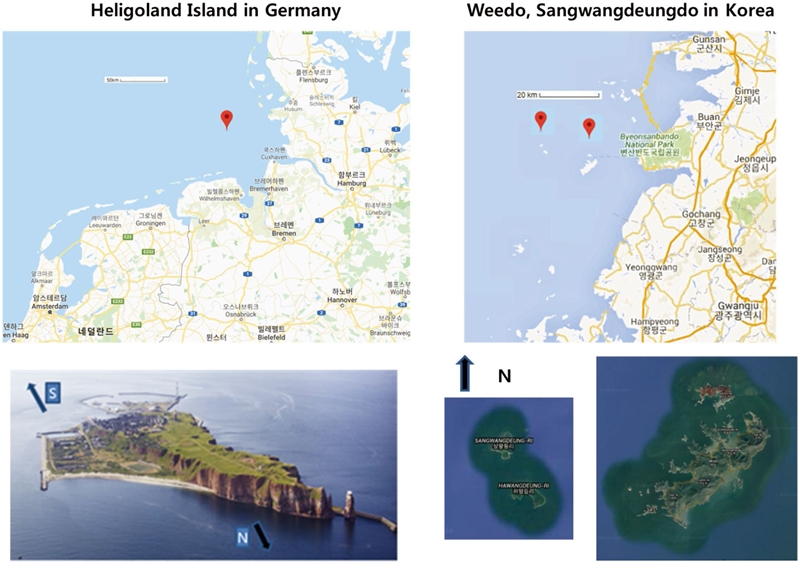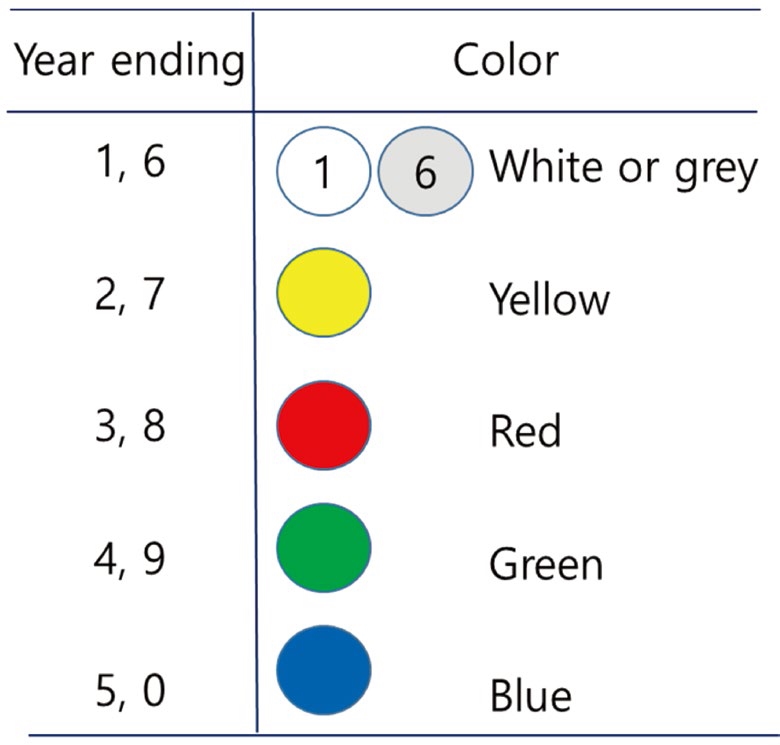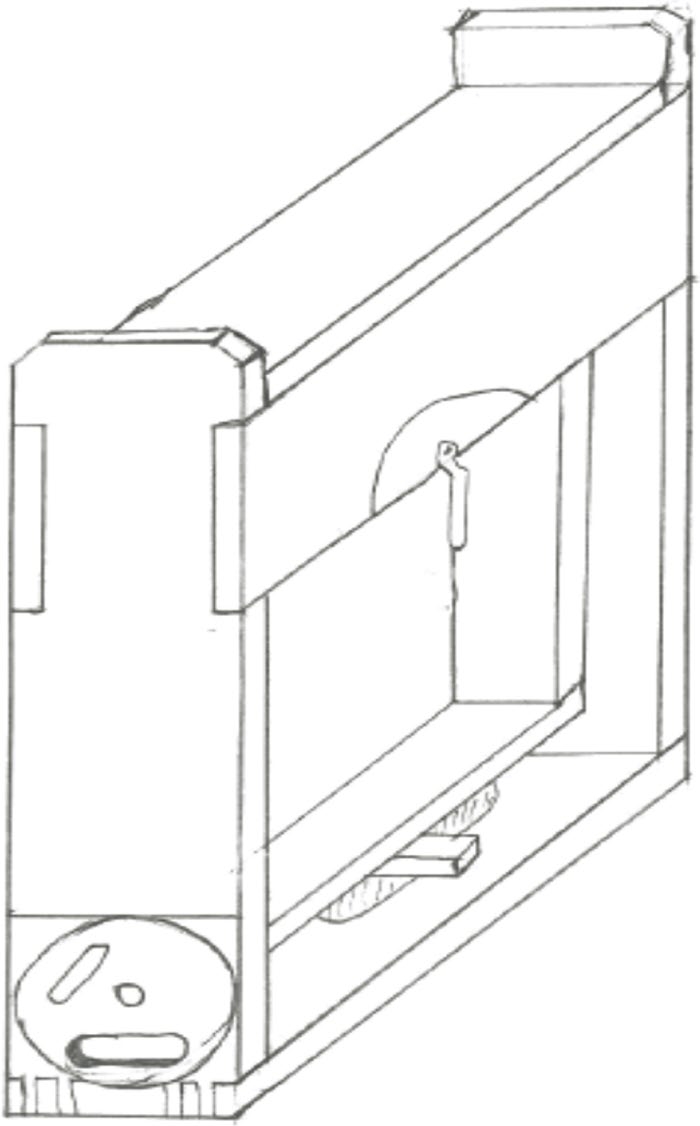
Remote Honey Bee Breeding Centre: A Case Study of Heligoland Island in Germany
Abstract
The honey bee queen shows extreme polyandry and controlling the mating partners can only be possible either by artificial insemination or having remote isolated mating locations. Here we report on the German North Sea island of Heligoland. Because of its location 60 km from the mainland, the lack of a local population of honey bees, its size of just 1.4 km2 and suitable weather conditions during the months of May to July, it is considered an ideal location for controlled inseminations of high-quality virgin queen bees with drones deemed genetically superior to others. Methods how to rear virgin queen bees are described and information is provided on the numbers of queen bees, their supporting workers and drone bees that are taken to the island in the mating season. The bee most commonly involved in the Heligoland mating trials has become Apis mellifera carnica strain “Baltica”. In one summer, for example, 80 virgin queens (belonging to beekeepers from nine different locations in northern Germany) each with about 600 worker bees plus two drone populations of around 2,000 drones were taken by ship to Heligoland. On their return to the mainland no later than 3.5 weeks after the mating exercise, the beekeepers could register a mating success rate of 80%. This information can help operation management of the new remote mating centre of Weedo Island, Jeonbuk in Korea, which is currently under construction.
Keywords:
Virgin queen bee, Controlled mating, Reproduction, Superior genetics, Rearing of queen beesINTRODUCTION
The success that a beekeeper associates with a hive is usually measured in terms of the amount of honey that the hive produces during the flowering season. This success depends on a variety of factors like, to name but the most important ones, the place and environment the hive is located in, the amount of food available to the bees, the weather conditions during the pollen and nectar collecting forays as well as the presence and virulence of parasites present in and outside the hive. However, crucial in all this is the genetic make-up of the queen bee as she is the only individual of a colony that lays eggs which develop into worker bees (Watson, 1928).
What breeders are therefore looking for is a queen that is resistant to diseases and parasites, that produces a lot of eggs and has a long and productive life span (although commercial bee keepers usually replace queens every one or two years even if a queen bee may live several years longer: Johnstone, 2008). Various methods have been suggested to predict a queen bee’s reproductive quality (Delaney et al., 2010), but since only worker bees are the progeny of fertilized eggs and drones are the result of unfertilized eggs, the mating partners of a queen need to be of an equally high genetic quality. It is no easy task to make sure that virgin queens deemed genetically superior to others will only mate with drone bees carefully selected for their genetic condition, given that mating takes place in the air usually not in the vicinity of the bee keeper. The difficulty is compounded by the fact that on their nuptial flights of usually 10 to 30 minutes (Koeniger and Koeniger, 2007), carried out a few times over a period of two or three days, 10~20 different drones may succeed in leaving their sperm in the spermatheca of the queen bee that they were able to copulate with. Although the virgin queen bee has some way to select the best suitors by flying rapidly around and reaching considerable heights (up to 40 m on the island of Heligoland: Kühl, 2011) to make the fittest drones keep up with her, less desirable males may nevertheless also manage to copulate with the virgin queen.
One way to make sure that only those drones deemed desirable will mate with selected queen bees is to use artificial insemination. Although widely practiced in some countries by commercial breeders, it is not a method that everyone has access to or even wishes to use. An alternative is to take high quality virgin queen bees together with some foragers of her colony to an offshore island that does not have any resident bee populations and release them one or two days after a large number of drone bees, also taken to the island, have earlier been released over the remote piece of land.
An island chosen by apiarists for their selective breeding experimentations, needs to fulfil certain criteria. Although honey bees are capable of foraging flights as far as around 12 km from the hive (Eckert, 1933), they rarely forage further away than 6 km and they do not normally like to fly across water as there are no landmarks (apart from the polarization pattern of the sky, which bees can and do use for orientation purposes: Von Frisch, 1949; Rossel et al., 1978; Rossel and Wehner, 1986; Kraft et al., 2011) to navigate by. Losing altitude and flying low in search of some landmarks, the bees tend to crash into the water and drown (Heran and Lindauer, 1963).
Therefore, since flights further than 12 km away from the hive are not usually undertaken by honey bees, a distance of at least 12 km has to lie between the mainland and the chosen island. The island must not be a very windy or rainy place and it needs to be of a certain size, because if it is too small, bees could be blown off-course and end up in the water and perish. The time of year for the mating trials has to be carefully chosen to coincide with the willingness of the honey bees to engage in nuptial flights and temperature and other weather conditions have to be optimal. Some greenery, trees and shrubs in bloom and flowers ought to be present as well. Here we report examples of ideal locations like the island of Heligoland for the controlled mating of honey bee queens with selected drone populations from Germany. Also we compare some aspects with the Korean honey bee breeding centre in Weedo, Cheonbuk Province (Fig. 1). This contribution is thus a reminder of the more than 100 year old connections between German and Korean bee keepers (involving the introduced Western honey bee A. mellifera) when the Benedictine monk P. P. Canisius Kügelgen (구걸근) wrote his “ABRISS BIENENZUCHT” (양봉요지) probably in 1912 while on a religious mission (Jung, 2014).
GEOGRAPHIC CHARACTERISTICS OF CONTROLLED MATING PLACES
Heligoland (in German known as “Helgoland” and in the local Helgolandic Frisian language as “Deat Lun”) is the island this report is mainly about. It was a British possession until 1890 when it was exchanged for the then German East African colony of Zanzibar. Heligoland meets all the criteria of an ideal place for controlled natural inseminations of virgin queen bees as it is approximately 60 km away from the nearest mainland, covers an area of around 1.4 km2, possesses ample vegetation, and has links by ferry and air to the mainland.
On the “Unterland” (the low-lying portion on the southeastern side of the island 2~3 m above sea level) there is a wide area with a lot of growth of rosehip (Rosea rugosa), black berry (Rubus sp.) and other flowering species. This area is sheltered from the predominating northerly and westerly winds by a cliff from the “Oberland” (45~55 m high upper portion of the island) and is therefore perhaps a better place for the release of honey bees for the purpose of controlled mating than the “Oberland”, where during the early years of the operation nuptial flights were arranged to take place near the island’s Ornithological Research Station. There is an abundance of plants in both areas (upper and lower land), but local weather conditions during the time that the mating trials are being carried out (sometime between early May and mid-July) can usually be expected to be more favourable for such undertakings in the lower southeastern portion of the island (Table 1).
The second most commonly used island in Germany for controlled honey bee mating events is the 0.54 km2 large Greifswalder “Oie Island” in the Baltic Sea, but it is located only 12 km from the mainland of the north-eastern German state of Mecklenburg-Vorpommern’s largest island of Usedom (the latter only separated from the mainland by a narrow channel). The area is known as the sunniest region of Germany, but in contrast to Heligoland honey bee mating events are only conducted there during the month of July.
Similar cases are found in Korea. Controlled honey bee mating experiments have been conducted on the 14.3 km2 large Weedo Island, 13 km off the Korean southwestern coastline of Jeonbuk’s Buan-Gun district (Lee et al., 2013). The vegetation of the island is quite diverse and composed of Eurya japonica, Camellia japonica, Prunus sargentii and Brassica napus in April, Rosa multiflora and Styrax japonicus in May, Actinidia arguta in June, and Sesamum indicum, Platycodon grandiflorum, Oenothera biennis and Humulus japonicus in July (Lee et al., 2013). Separation by 13 km from the nearest coastline provides sufficient isolation. In a report by Lee et al. (2019) delivered at the Apicultural Conference in Andong/South Korea (August 22nd, 2019), it was stated that six drone colonies and five mating boxes were placed on the island, Sangwangdeungdo, 0.57 km2 large, 31 km away from the Buan-gun behind Weedo on April 30th, while the virgin queens emerged on May 1st. The number of virgin queens was 20 and according to Lee et al. (2019) ”the mating box was divided into 4 sections for each virgin queen”. The mating success recorded from these two island studies was 66~75% (Lee et al., 2013, 2019).
REARING OF QUEEN BEES
The first step in preparing to select specific individuals for any controlled mating experiment whether in Germany for Heligoland and other North Sea islands or Korea in the case of Weedo, is to rear a sufficient number of queen bees. The required larvae have to come from colonies known for their superior qualities with regard to above-average honey production, resistance to parasites and disease, docility, and willingness to delay swarm formation. The host colony (also known as feeding colony), needed to rear the queen larvae, on the other hand has to have distinguished itself as a healthy and brood-strong colony, not in the mood of swarm-formation.
To transfer the queen larvae, the latter must not be older than 1.5 days. The cells can be expected to release the virgin queens 12~13 days later. The next day small (or shortly before a virgin queen’s emergence) mating colonies need to be established and three or a few days after that, these small colonies can be sent to the island, where the controlled mating is expected to take place.
Several methods are in use to rear queen bees (e.g. a method described by Pan et al. (2013) without larval grafting or the more traditional methods explained below in this paper), but they all have in common that there is only a relatively small window each year that is most suitable for this purpose. For Heligoland it is common that virgin queen bees will be reared in May. One common method (Fig. 2) sees the resident queen of the host colony, which is easily recognizable on account of her larger size, longer abdomen and pea shaped thorax, carefully isolated about 9 days before she is totally removed and the 12 to 36 hour old well pre-fed bee larvae in a frame from the breeding colony can be inserted into a space in the host colony created by the removal of one frame.
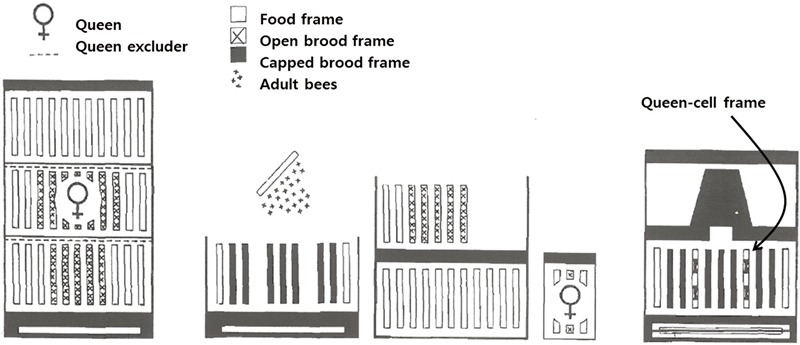
Honeybee queen breeding procedures in queen-less colony. 1) Selecting a healthy, strong hive with queen excluder on the top of the brood chamber. 2) Separating the space in the brood chamber and adding adult bees, but keeping the chamber without the queen. 3) Establishing the queen-cell frame and inserting it into the chamber (Modified after Dustmann et al., 1992).
Artificial queen cell cups are essential and made of wax or plastic to be attached to cell bars with hot beeswax, no more than 20 cells for each bar. The cells of the inserted frame are shortened by 1/3 to facilitate enlargement and widening of the cell cups by the host bees. It is possible to purchase artificial queen bee cell cups into which with great care the young larvae are introduced by hand; a process termed grafting for which special larval transfer equipment like spoons or grafting needles is available, e.g. from www.imkereibedarf-bienenweber.de/interesting-facts/Nicot-breeding-equipment-plastic.
Larvae 0~24 hours old are no bigger than a queen bee’s egg, but transferring eggs is not recommended. However, the younger the transferred larvae are, the better the queens they may turn into is the accepted view. A queen excluder is required, but the resident queen can be kept with a few accompanying bees in a separate compartment of a multi-chamber hive. The entrance to the hive is blocked to avoid the possible arrival of another queen.
A few hours after the queen has been removed the buzzing sounds of the worker bees indicate that they have noticed their queen’s absence. It is actually at this moment that the beekeeper inserts the frame with about 20 larvae in the space that he s/he had prepared earlier during the time the resident queen was confined to one area of the hive. From then on the larvae need a large amount of royal jelly food, which is why it is essential that there is sufficient nutritious material available for the larvae and that the latter have been accepted by the host’s nurse bees. This should be carefully checked after 24 hours.
Other methods exist (Fig. 3) and often involve so-called “pre-breeding” boxes and “Starter and Finisher” boxes (https://av.tib.eu/media/9244; https://doi.org/10.3203/IWF/C-1801). Swarm boxes, often referred to as “Swathmore swarm boxes” (see: http://www.dave-cushman.net/bee/swarmboxcellstart.html), have proved useful. However, irrespective of which method is used, the goals are always the same and in principle the techniques always depend on a queen-deprived colony (the “feeders”) or section of the colony to accept and rear queen bees from the brood of a selected colony that differs from that of the feeders.
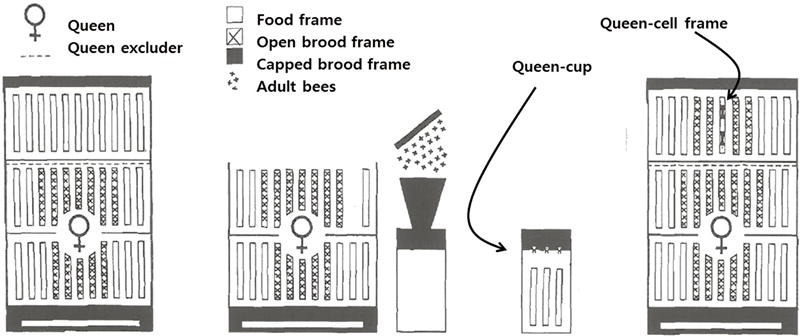
Queen breeding in pre-breeding box. 1) Selecting healthy strong colony. 2) Shaking adult bees to the pre-breeding box. 3) Providing honey and pollen frames and 50~60 queen cups. 4) Inserting the queen-cell frame into 3rd floor of original colony with broods (Modified after Dustmann et al., 1992).
Five days after the larval transfer, the queen cells have been capped and covered by the worker bees of the host colony. After approximately 10 days before the queen bees emerge, the cells need to be removed from the host hive and caged, i.e. placed individually into small mating nuclei colonies (one for each queen). Size and appearance of the cells are not necessarily related to the quality of the queen bee inside the cell, for that depends entirely on the type and quantity of the food the larva was given and the age it was grafted.
The cages in which the newly emerging queens will be kept need to be supplied with a small container of honey and may be made out of wood or other materials. Cages known in Germany as “Zanderkaefig” contain a rotatable disc on one side and wire or gauze on the other. The cells have to be always in a vertical position and need to be kept at a temperature of 35°C and a humidity of 50~70%. The last phase of the breeding need not take place in the hive but can be performed in a brood cabinet. If the latter is used, the brood in it should be checked twice a day.
The new queen bees exit from their cells by gnawing through the waxy cover of the cells from the inside. Lower temperatures delay the time it takes a queen to escape from her cell while higher temperatures can lead to a premature emergence. If it is noticed that queen bees experience problems in leaving their cells, help can be provided by carefully cutting the cell wall. Once a queen bee has emerged then empty cell needs to be removed, because some queen bees have a tendency to crawl back into their cell. No new queen should remain without worker bees for longer than 24 hours. Of course if queen cells hatch inside of the mating nuclei this could not happen, but if reared in isolation this point is important.
Each new queen bee has to be marked and to be identifiable. In Germany small convexly bent thin and coloured discs made of “opalith” are available for that purpose with numbers printed on them. The colour code is international and includes white (or grey) for years ending in 1 or 6, yellow for years ending in 2 or 7, red for years ending in 3 or 8, green for years ending in 4 or 9, and blue for years ending in 5 or 0 (Fig. 4).
Marking a queen bee has to occur in a closed room. The queen is encouraged to run across the beekeeper’s hand, who then carefully grabs the bee with thumb and index finger and holds it in such a way that the dorsal side points upward. With the help of the blunt head of a needle the beekeeper then places a drop of shellac onto the bee’s back, making sure no stickiness has reached the wings. With the moist opposite end of the needle the beekeeper then picks up an opalith disc and places it on the shellac on the bee’s back. Before being returned to its cage, the marked bee is allowed to run across the hand in order to have its legs and movement behaviour checked for normality.
Very soon and at the latest two days after a queen bee’s emergence, the young queen needs to be accommodated together with a small support colony in a mating box. The supporting workers may stem from the feeding host colony or another population that must not be in the process of forming a swarm. It is essential that no drones are among the support bees. Food in the form of honey combs from the host hive has to be present in the offshoot box as well as a grid to keep out drones. Worker bees run into the dark interior and form a cluster around the queen in her cage. Additional bees that are mostly older ones are brushed off and allowed to fly away, so that predominantly young bees remain. The drones that have assembled in front of the grid are removed, the box will be closed and kept overnight in a dark and cool place. Commonly 15~20 small mating support colonies can be formed from the host colony.
TRANSPORT TO AND FROM THE ISLAND
In order to transport the small mating support colonies to the island, boxes known as “Kirchhainer Kaestchen” (moving-box with handle) in Germany have proved very successful (Fig. 5). To fill a box with the bees, the latter are briefly showered with a fine spray of water and the queen bee is gently pushed out of its cage onto the bottom of the box and then the wet support bees are added. These procedures need to be done fairly quickly. So that the new queen and her workers may bond and become a unit, the entrance hole will be closed for 3~4 days and the boxes will be stored in a darkened room at a temperature of 15~20°C. The bees will then start to construct combs. It is necessary to provide sufficient aeration and an adequate supply of water and honey. One-frame boxes are preferred and used when the bees are to be sent to Heligoland for mating (Fig. 6).
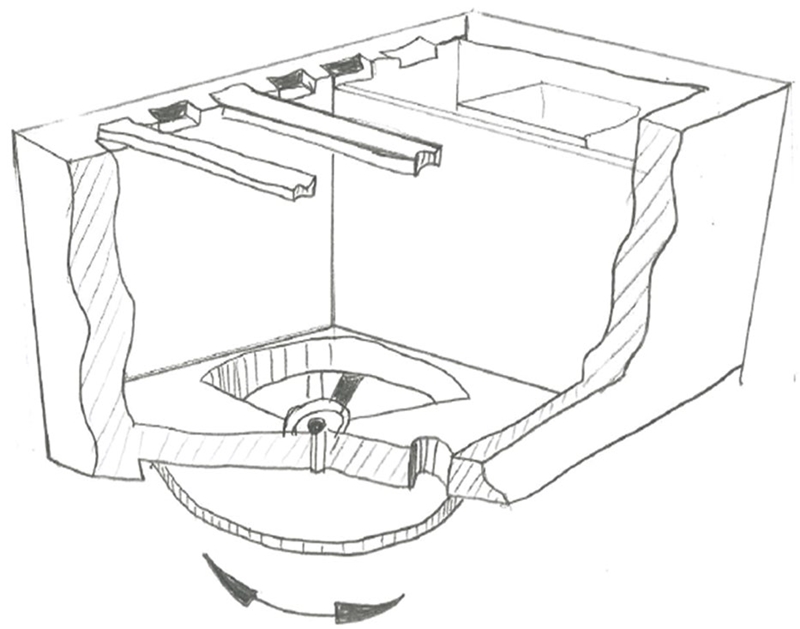
“Kirchhainer Kaestchen” bee box with virgin queen bee at the bottom and small number of worker bees plus some food. This device is designed for worker bees to move downward only.
Each one-frame box is to be supplied with about 0.24 L of bees and adequate food. As with the Kirchhainer Kaestchen (see above) 15~20 one-frame boxes can be filled with the bees of the host hive. The boxes are oriented vertically so that when the queen wetted with lukewarm water is inserted the workers can form a cluster that is freely hanging from the top. The cluster should have a size that fills about half of the space of the box. If there are too many bees, they may swarm out when the mating island is reached and when there are too few bees in the cluster, the queen may get too cold and suffer some problems. As with the multi-frame boxes, the one-frame boxes should be kept for 3 days in a cool and dark room or a shady place so that the queen and the support bees forge a unit. To prevent the queen from leaving, only one small exit hole for the workers will be opened. Should after three days the bees have started to construct a comb, then that is a sign of success.
Only one-frame boxes that show sufficient comb construction should be sent to the mating island. Each box has to contain the name and address of the owner of the bees and stickers on the box to alert railway, ferry or airplane staff of the contents of the boxes. Once the bees have calmed down enough following the transport to the island, the entrance hole is opened. Meanwhile there should already have been a carefully selected drone population on the island, so that 6 days after their emergence, when the queens are most willing to mate and to undertake their nuptial flights, a large enough number of drones is already present.
MATING CONTROL
To ensure that high quality drones are present, drone hives should be placed a fair distance away from the queen mating apiary or drones have to be taken to the island prior to the arrival of the virgin queen bees. Drones must be unrelated to the virgin queens and drone mother colonies must receive a similar amount of attention as a cell feeder hive. According to Johnstone (2008) drones should hatch at a time when grafting queen cells commences and “a full frame of drone brood will produce around 700 mature drones.” Drone brood take 24 days to hatch and although they may live up to 60 days their fertility declines after 28 days.
It is estimated that for 200 queens one needs to have 8 drone mother colonies (Kühl, 2011). During the last few years two beekeepers on Heligoland have managed to successfully keep their hives going over the winter. However, their colonies are always exchanged in spring, so that up-to-date genetic material is available on the island. Drones do not contribute anything to the colony and their sole function is to fertilize virgin queens. During their nuptial flights on Heligoland it is estimated that the queens may mate with on average 8~12 drones (maximally 25), provided the environmental temperature is at least 20℃. Drones usually end up demasculinized following copulations with a queen and die soon thereafter.
A few days after the cessation of the nuptial flights the successfully mated queen bees start laying eggs and establish their brood nest (Johnstone, 2008). The beekeeper can check whether the brood consists of normal workers, namely if the cells have a flat cover. Should fertilized eggs be present and worker brood is produced then the mating boxes will be sent back to their owners as they are not kept longer than a few weeks on the island. Should a queen start to lay unfertilized eggs, then this is easy to spot as such cells have a higher lid. To wait longer than three weeks for queens to start laying eggs is useless. Details about the times that the queens started laying eggs and the kinds of eggs laid by them (whether fertilized or not) plus any other noteworthy observations like pedigree of the drone brood are entered into the queen bee’s log-book (a kind of ‘passport’ every queen has) by the island’s chief responsible person to supervise the mating events. On average a queen will then lay around 2,000 eggs a day for the rest of her life.
For example, in one summer session in Heligoland 80 virgin queens (belonging to beekeepers from nine different locations in northern Germany) each with about 600 worker bees plus two drone populations of around 2,000 drones were taken by ship to Heligoland. On their return to the mainland no later than 3.5 weeks after the mating exercise the beekeepers could register a mating success rate of 80%, which suggests the vitality of the drones involved was excellent.
Although several German North Sea islands can and do serve as controlled mating places for honey bees, Heligoland is the only “Reinzuchtbelegstelle”, which means that because of its distance to the mainland (unlike other islands that are closer to the mainland) stray drones cannot be present and are 100% excluded. Over the last 60 years 11,500 queens were successfully inseminated by drones there. Annually around 150 virgin queens are taken to Heligoland alone. Because of Heligoland’s climate the mating usually starts in mid-June, but colonies may be taken to the island already in May and boxes may be left there until mid-July. The bee most successfully involved in the Heligoland mating trials has become Apis mellifera carnica strain “Baltica”. Incidentally, queen honey bees can be purchased and sell for around 30 Euros each in Germany.
Additional information is available from www.bienenundnatur.de (Deutscher Landwirtschaftsverlag GmbH, München), who publish the magazine for apiarists and beelovers “Bienen & Natur” and can be contacted via bienenredaktion@dlv.de. The journal “Deutsches Bienen Journal” (www.bienenjournal.de) is published by the Deutscher Bauernverlag GmbH (Berlin) and contactable via bienenjournal@bauernverlag.de. Additionally there are several more local honey bee societies and organizations that publish their own newsletters and magazines. In Switzerland the “Bienen Zeitung” can be contacted via sekretariat@apisuisse.ch.
CONCLUSIONS
Successful beekeeping is associated with conservation of the genetic make-up of the queen bee with the target characteristics such as the capacity of honey collection or disease resistance etc. For the conservation and improvement of the genetic diversity of honeybee, artificial insemination or having remote isolated mating locations play roles for the controlled mating. This paper reports on the German North Sea island of Heligoland as a remote place to conduct controlled mating to produce honeybee queens with desired characters without genetic contamination or mix-up. The processes for queen and drone production as well as the movement from the source apiaries to the mating place were detailed with some instrumental introductions. This information can be vitally important to help design and managing the new controlled mating centre on the remote island, Weedo, 13 km off the coastline of Jeonbuk’s Buan-Gun district, i.e. the southwestern part of Korea.
Acknowledgments
We wish to thank Dr Vincent Schulz-Douglas for having sponsored the trip to the island of Heligoland during the month of July in 2019 and Mr Carsten Knop of Beldorf (Germany) for information on the Heligoland queen bee mating operations that he has been in charge of for the last few years. Mrs Lee Min-Ah assisted VBM-R on Heligoland in the field. This research was partly supported by the BSRP, NRF Korea (NRF-2018R1A6A1A03024862), and a Climate Change and Insect monitoring Research Project, RDA, grant number PJ013463042018.
References
-
Delaney, D. A. , J. J. Keller, J. R. Caren and D. R. Tarpy. 2011. The physical, insemination, and reproductive quality of honey bee queens (Apis mellifera L). Apidologie 42: 1-13.
[https://doi.org/10.1051/apido/2010027]

-
Dustmann, J. H., E. Schönberger, H. Schönberger and F. K. Tiesler. 1992. Aufzucht von Bienenköniginnen. IWFGöttingen.
[https://doi.org/10.3203/IWF/C-1801]

- Eckert, J. E. 1933 The flight range of the honeybee. J. Agricultural Research 47(8): 257-285.
-
Frisch, K. V. 1949. Die Polarisation des Himmelslichtes als orientierender Faktor bei den Tänzen der Bienen. Experientia 5: 142-148.
[https://doi.org/10.1007/BF02174424]

-
Heran, H. and M. Lindauer. 1963. Windkompensation und Seitenwindkorrektur der Bienen beim Flug über Wasser. Zeitschrift für Vergleichende Physiologie 47(1): 39-55.
[https://doi.org/10.1007/BF00342890]

- Johnstone, M. 2008. Rearing queen bees. https://masterbeekeeping.com/images/queen_rearing/Rearing-queen-bees.pdf, .
- Jung, C. 2014. A note on the early publication of beekeeping of Western Honeybee, Apis mellifera in Korea: Yangbong Yoji (Abriss Bienenzucht) by P. Canisius Kugelgen. J. Apiculture 29(1): 73-77.
-
Koeniger, N. and G. Koeniger. 2007. Mating flight duration of Apis mellifera queens: as short as possible, as long as necessary. Apidologie 38: 606-611.
[https://doi.org/10.1051/apido:2007060]

-
Kraft, P., C. Evangelista, M. Dacke, T. Labhart and M. V. Srinivasan. 2011. Honey bee navigation: following routes using polarized-light cues. Phil. Trans. R. Soc. B 366: 703-708.
[https://doi.org/10.1098/rstb.2010.0203]

- Kühl, H. J. 2011. Drei Flitterwochen für Königinnen. Schleswig Holsteinische Landeszeitung 27 Juli 2011 https://www.shz.de/lokales/landeszeitung/drei-flitterwochen-fuerkoeniginnen-id1545361.html, .
- Lee, M.-Y., M.-L. Lee, I.-P. Hong, S. W. Woo, H. S. Sim, Y. S. Choi, G. H. Byoun, J. M. Kim and M. R. Cho. 2013. Using possibility of island as isolated honey Bee breeding apiary. Korean J. Apiculture 28: 361-365.
- Lee, M.-Y., Y. S. Choi, D. W. Kim, E. J. Kang, T. H. Oh, S. H. Park. 2019. Mating effect of honey bee (Apis mellifera in isolated small islands. In: Program and Abstracts (The 36th Conference and Symposium of the Apicultural Society of Korea), p. 97.
- Pan, Q. Z., X. B. Wu, C. Guan and Z. J. Zeng. 2013. A new method of queen rearing without grafting larvae. Am. Bee Journal 12: 1279-1280.
-
Rossel, S. and R. Wehner. 1982. The bee’s map of the e-vector pattern in the sky. Proc. Natl Acad. Sci. USA 79: 4451-4455.
[https://doi.org/10.1073/pnas.79.14.4451]

-
Rossel, S. and R. Wehner. 1986. Polarization vision in bees. Nature 323, 128-131.
[https://doi.org/10.1038/323128a0]

-
Rossel, S., R. Wehner and M. Lindauer. 1978. E-vector orientation in bees. J. Comp. Physiol. 125: 1-12.
[https://doi.org/10.1007/BF00656826]

-
Watson, L. R. 1928. Controlled Mating in Honey bees. The Quarterly Review of Biology 3: 377-390.
[https://doi.org/10.1086/394310]

